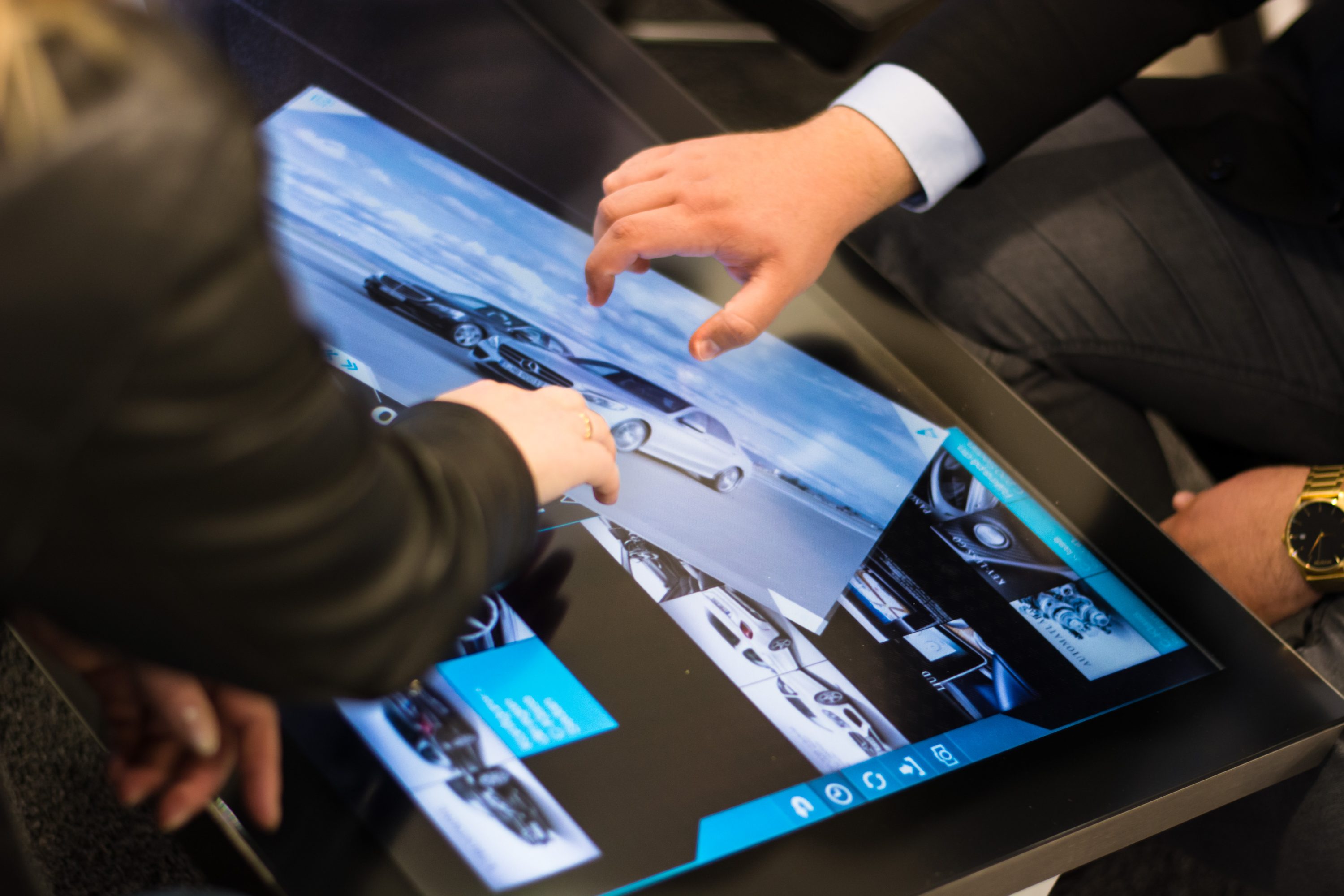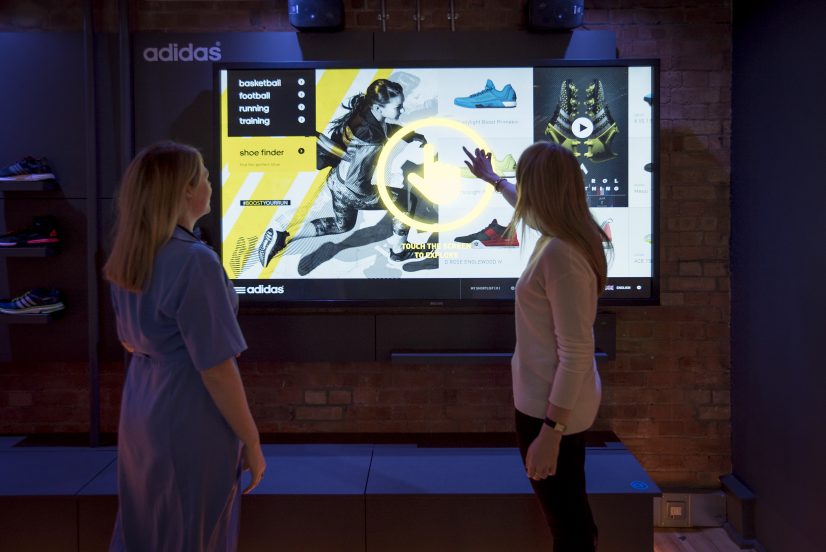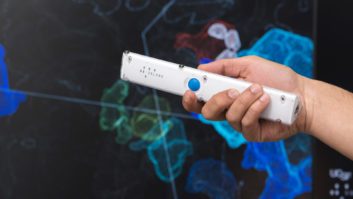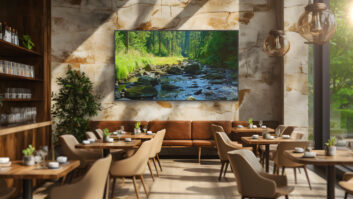
Over the past few years, innovation in touchscreen technology has mainly been in the smartphone arena – but as companies look to an open market for larger interactive displays, some of that functionality is starting to permeate pro AV.
The current state of the interactive displays market is one of fragmentation, a consequence of no single technology having emerged to dominate market share. However, some exciting innovations from mobile device categories are having an impact on the sector.
Touch technology manufacturers and developers have flooded the pro-AV marketplace with competing ideas and technologies, having experienced a slowing of growth in the smartphone sector where projected capacitive (PCAP) technology dominates. A key factor is plummeting touchpanel production costs, particularly for components such as sensors and cover glass. This has led to a wave of traditional display makers also entering the market, leaving specialist touch suppliers squeezed. The end result of this market activity, according to a report by the Business Research Company, is that while unit volume will experience healthy growth, revenue is forecast to grow much more slowly in the coming years.
“There are many players in the market and the users are being overwhelmed with what is great for now and what has a futureproof potential,” says Alexander Haydari, SVP of business development at Swedish interactive software developer Touchtech.
There are currently five established touch technologies – PCAP and IR (optical), which remain the two incumbent technologies, as well as capacitive, resistive and SAW (surface acoustic wave). While PCAP outperforms the competition in mobile device categories, questions have been raised over the scalability of its standard conductive sensors above standard tablet size. Replacement sensor materials have been developed to support larger sizes, but these require the sensor matrix to be further divided into segments. This creates a non-scalable architecture that needs to be significantly modified to support different sizes.
IR can offer the user more clarity than resistive and capacitive, as there is no overlay or additional screen. Other advantages are its scalability to larger sizes and scratch-resistant surface; however, IR does require a bezel and a flat surface so cannot be designed as a curved solution. Other issues include sensitivity to ambient light interference and its higher cost.
An exciting and disruptive touch technology is InGlass, developed by FlatFrog. This is claimed to combine the best qualities of the other technologies, such as touch performance, bezel-free design, scalability and curve support, to ensure it is better equipped for future trends. It is a ‘frustrated total internal reflection’ (FTIR) based technology, which operates by injecting specific wavelengths into the core glass and using novel algorithms to detect touch disturbances. Frieder Hansen, CEO at Pyramid Computer, comments: “InGlass has several benefits over other touch technologies. Compared to PCAP, InGlass offers a better glass rendering which is crystal clear and virtually invisible, while allowing more brightness and larger size displays. When compared with IR technology, InGlass doesn’t create any shadows, doesn’t get as dirty with fingerprints, making it look nicer, and the touch capability will work better when the same X or Y lines are touched at the same time.”
Key trends
Sorting through these technologies to define the market and draw a clear direction of travel is no mean feat, but a number of key trends have surfaced. Some of them mirror developments in display technology in general, for example larger screen sizes becoming the norm, as are higher resolutions, and devices being designed to be more aesthetically pleasing.
“The current advancements of touch technology is about improving optics and clarity,” says Haydari. “Traditional capacitive technologies that used copper wire are now moving towards materials that are naked to the eye. Micromesh is one capacitive touch technology that has emerged and has become a game changer in the current marketplace.
“Many technologies are also incorporating active stylus response that used to be the domain for Bluetooth- or sound-enabled devices. The touch sensors are getting much better at detecting different sizes, shapes etc to accomplish the demand for higher accuracy and response rates. With this move forward the prices have also made the market more competitive, enabling more devices to be incorporated into different projects.”

Fundamental shift
While many touch specialists have sought to gain a foothold in the commercial touchscreen market as growth in the smartphone has stuttered, mobile phones and tablets have brought about a fundamental shift in users’ expectations.
“I think the ‘just like the app on my iPhone’ has created a fundamental leap in the expectations of the public and clients alike,” comments Steve Blyth, CEO of Engage Works. “Large-scale displays have not quite kept up with this, and when they do I think that will create a big shift in the market.”
Haydari adds: “Smartphones and tablets have set a standard of the type of quality a user expects for large-format touchscreens. Gone are the days of ‘good enough’. It is now about speed, accuracy and clarity. Users have become so accustomed to having things happen right away. If the touch response is not good enough then more users start to abandon touch-enabled solutions.”
An innovation from smartphones, or more specifically from the iPhone, that has the potential to make waves across larger format interactive displays, is ‘pressure detection’ or ‘force sensing’, coined as 3D Touch by Apple. “Pressure detection is seen as an area with a long-term future,” says Blyth. This functionality is still very much in its infancy in pro-AV touchscreens, with only a few companies offering something similar, but many more are already looking at it for 2017.
Ian Crosby, Zytronic’s sales and marketing director, explains the complexities and scalability of the technology: “Extending force sensing from handheld devices to large touchscreens used in commercial applications is much more than a matter of simply scaling up the same technology, and is based on measuring the surface area of the touch, which will increase as more pressure is applied. The feature is entirely implemented in the touch controller firmware, so existing customers could retrofit force sensing by refreshing the firmware and adapting their application software to respond appropriately using Zytronic’s proprietary application programming interface (API).”
Ahead of its time
Nathan Moyal, VP marketing at FlatFrog, comments: “For too long we have accepted that we can only move objects in X and Y. But, why not in Z? In the case of pressure, we internally felt that the innovation was worthy of bringing forward even if it was ahead of its time.
“Pressure is not available on every touch technology. There are painful ways to try to add pressure. For example, you could add physical pressure sensors under the screen to complement the touch. However, in many cases these are patches and add-on options as opposed to a technology that is inherently capable of detecting multi-touch and the quality of the touch for each independent touch point. In our case, we don’t just detect pressure, but we can detect it well with 1024 pressure levels.
“In some applications such as banking or gambling, an error-proof selection is essential. It is convenient when our touchscreens are responsive. However, for some key selection items, we require another level of safety. For example, an inadvertent touch can be replaced with a soft touch to select and a harder press to trigger.”
Haydari offers: “Pressure touch will need a software solution that makes it natural for the user to interact with the devices by pushing down harder. Software and hardware developers will be looking towards the major players such as Apple, Samsung and Microsoft to educate.”
In terms of the what this could offer AV applications, Haydari states: “Pressure touch can enable menu selection, zoom in and zoom out, and annotation features; however, this function will depend on the use case and the environment of where these displays are placed and for what purpose.”
Crosby adds: “Force sensing can be used to highlight a product or service selection initially with a light touch, and the choice only being confirmed fully with a firmer press, providing the opportunity to make the technology more accessible to partially sighted users. A practical application for this could be on an ATM, whereby an initial touch triggers an audio confirmation of the amount of cash to be withdrawn, and then increasing the force activates the choice.”
When will it hit the mainstream of the AV industry? Haydari suggests: “Right now I believe pressure touch is here and is only going to improve; however the adoption can be anytime. Technology adoptions move really fast. Just look at augmented reality: this technology has been around for quite some time, but it was not until it was properly used to push the user to better understand it that it has become widely accepted.”
The Business Research Company reports that while the market is currently in a state of flux, this could be resolved due to market forces such as falling margins and increased competition. Going forward this is expected to lead to a number of diversified companies de-prioritising the touchscreen sector to focus on core technologies.
With the advances being made in touch technology, manufacturers and developers in this space must be keenly aware that users’ expectations have been recalibrated by their day-to-day smartphone experiences, raising the bar for interactive displays going forward.
www.thebusinessresearchcompany.com
http://engageldn.engageworks.com
www.flatfrog.com
www.pyramid-computer.com
www.touchtech.com
www.zytronic.co.uk







